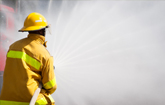NEW YORK, Oct. 27, 2015 /PRNewswire/ -- REPORT HIGHLIGHTS
The U.S. market for advanced protective gear and armor has reached $4.5 billion and $4.7 billion in 2013 and 2014, respectively. This market is expected to reach at compound annual growth rate (CAGR) of 4.4% to nearly $5.9 billion in 2019.
This report provides:
An overview of the U.S. market for advanced protective gear and armor.
Analyses of the U.S. market trends, with data from 2013 and 2014, and projections of CAGRs through 2019.
Emphasis on the following sectors of the market:
Heat- and flame resistant clothing, including firefighters' turnout gear for structural, proximity, and wildlands fire service, as well as industrial fire resistant garments for use in electric and gas utilities or in industrial applications in which electric arc and flash fire are hazards.
Chemical protective garments and equipment, including chemical-resistant clothing, chemical or biological warfare and protective suits, and gloves used in industrial applications. Much of this same gear can be used for biological protection.
Respirators and ancillary components for fire and chemical/biological situations.
Body and vehicular armor, including bullet and fragmentation-resistant garments used in law enforcement and military applications.
Body armor, including bullet-resistant garments used in law enforcement and military applications. The retrofitting of vehicles using the same types of materials and some of the newer engineered in-place vehicle armor.
Coverage of market aspects including raw materials, technologies, market size, and anticipated growth.
SCOPE OF REPORT
The protective clothing, gear and armor markets are a fragmented industry. There are significant and specific segments of the protective clothing, gear and armor industry. Within each of these segments are a variety of players, including government organizations that create, develop and enforce regulations and standards, raw material suppliers, fiber and fabric manufacturers, mills and fabric producers, finished goods manufacturers, and suppliers and distributors. The supply chain may be complex and at times difficult to understand. Our focus is on the major material types and the designers of the products rather than on the distributors of the products. To emphasize the complexity, it may be that one large corporation, through many of its parts, can be involved in all the sectors of the supply chain. This study of the advanced protective gear and armor markets focuses on the following major sectors in the U.S. market:
Heat- and flame-resistant clothing, including firefighters' turnout gear for structural, proximity and wildlands fire service, as well as industrial fire-resistant garments for use in electric and gas utilities or in industrial applications in which electric arc and flash fire are hazards.
Chemical protective garments and equipment, including chemical-resistant clothing, chemical or biological warfare and protective suits, and gloves used in industrial applications. Much of this same gear can be used for biological protection.
Respirators and ancillary components for fire and chemical/biological situations.
Body and vehicular armor, including bullet and fragmentation-resistant garments used in law enforcement and military applications.
Body armor, including bullet-resistant garments used in law enforcement and military applications. This includes the retrofitting of vehicles using the same types of materials and some of the newer engineered in-place vehicle armor.
Each of these areas of the personal protective clothing/equipment industry is discussed. Within each segment—chemical/biological, fire and projectiles/ explosives—the regulations, raw materials, technologies, market size and anticipated growth are covered. Manufacturers are evaluated and listed at the conclusion of each of the appropriate sections.
Although there are frequent mentions in military documents and in the popular press concerning nuclear, biological and chemical (NBC) or chemical, biological, radiological and nuclear (CBRN) equipment, this is excluded from our discussion. There is no truly protective clothing for severe nuclear threats such as battlefield nuclear explosions or a Chernobyl-level nuclear accident. When gamma rays are present in force and quantity, the effective absorbers might be lead or the misnomer "depleted" uranium. Respirators and clothing do help, but the best solution is situational awareness. The NBC misnomer continues; details of implied NBC are not included in this report.
The geographic scope of this report is the U.S. market.
Read the full report: http://www.reportlinker.com/p096638-summary/view-report.html
About Reportlinker
ReportLinker is an award-winning market research solution. Reportlinker reviews, finds and organizes the latest industry data so you get all the market research you need - instantly, in one place.
http://www.reportlinker.com
__________________________
Contact Clare: [email protected]
US: (339)-368-6001
Intl: +1 339-368-6001
SOURCE Reportlinker




Share this article